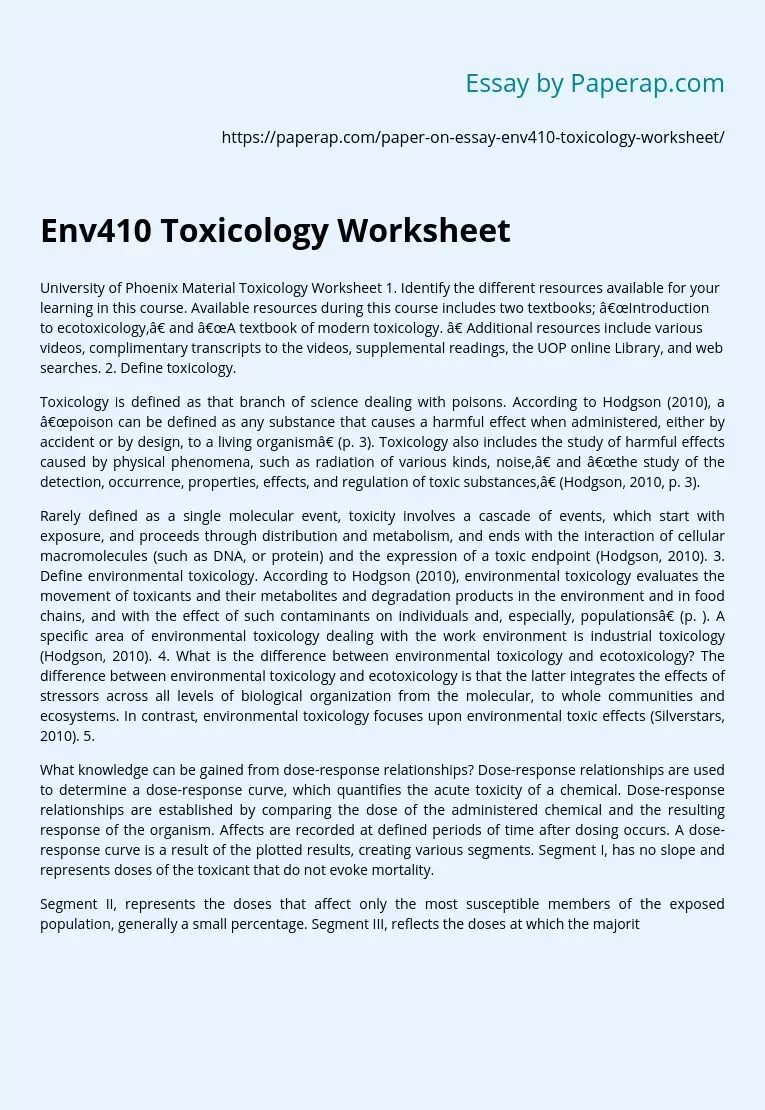Env410 Toxicology Worksheet
The following sample essay on University of Phoenix Material Toxicology Worksheet 1. Identify the different resources available for your learning in this course. Available resources during this course includes two textbooks; “Introduction to ecotoxicology,” and “A textbook of modern toxicology. ” Additional resources include various videos, complimentary transcripts to the videos, supplemental readings, the UOP online Library, and web searches. Define toxicology. Toxicology is defined as that branch of science dealing with poisons. According to Hodgson, a “poison can be defined as any substance that causes a harmful effect when administered, either by accident or by design, to a living organism”.
Toxicology also includes the study of harmful effects caused by physical phenomena, such as radiation of various kinds, noise,” and “the study of the detection, occurrence, properties, effects, and regulation of toxic substances”. Rarely defined as a single molecular event, toxicity involves a cascade of events, which start with exposure, and proceeds through distribution and metabolism, and ends with the interaction of cellular macromolecules (such as DNA, or protein) and the expression of a toxic endpoint.
Define environmental toxicology. According to Hodgson, environmental toxicology evaluates the movement of toxicants and their metabolites and degradation products in the environment and in food chains, and with the effect of such contaminants on individuals and, especially, populations”. A specific area of environmental toxicology dealing with the work environment is industrial toxicology. What is the difference between environmental toxicology and ecotoxicology? The difference between environmental toxicology and ecotoxicology is that the latter integrates the effects of stressors across all levels of biological organization from the molecular, to whole communities and ecosystems.
In contrast, environmental toxicology focuses upon environmental toxic effects. What knowledge can be gained from dose-response relationships? Dose-response relationships are used to determine a dose-response curve, which quantifies the acute toxicity of a chemical. Dose-response relationships are established by comparing the dose of the administered chemical and the resulting response of the organism. Affects are recorded at defined periods of time after dosing occurs. A dose-response curve is a result of the plotted results, creating various segments. Segment I, has no slope and represents doses of the toxicant that do not evoke mortality.
Segment II, represents the doses that affect only the most susceptible members of the exposed population, generally a small percentage. Segment III, reflects the doses at which the majority of the population eliciting some response to the toxicant, and is the steepest slope of all segments. Segment IV, identifies the doses of the toxicant that are toxic to even the most tolerant organisms of the population, which are generally high doses of the toxicant. Segment V, represents the doses at which all of the exposed organisms are affected, and has no slope. The LD50 of the toxicant is determined by using a well-defined dose-response data, logarithms and percentage effect to determine the probable units. Why are the shape and slope of a dose-response curve important? The shape and slope of a dose-response curve is important because the dose-response curves are used to derive dose estimates of chemical substances. The slope of the linearized data set from a dose-response curve provides information on the specificity of the toxicant. Steep slope elicit toxicity, whereas, shallow slopes elicit nonspecific toxicity.
The dose-response line also allows one to estimate the threshold dose, by defining the lowest dose expected to elicit a response. The threshold dose is one that is lower than the greatest dose at which no affect is detected. This is generally between segments I and II. What role do they play in environmental toxicology? This helps put toxins into exposure classes. This allows scientist to determine what level the toxins are lethal, or what levels may help prevent undesired medical conditions, such as cancer. These levels are used for regulatory purposes as well, to minimize exposure to harmful toxins and their effects on human health and the environment. Explain LD50. LD50 refers to the dose level (concentration level) of a toxic substance (poison) required to obtain a lethal dose that kills 50% of a population under stated conditions, such as the controlled variables of the study. This level is typically normalized to the weight of the animal (milligram chemical kilogram body weight), and the measure of acute toxicity is used to assign of toxicity to the given chemical.
Env410 Toxicology Worksheet. (2019, Jun 20). Retrieved from https://paperap.com/paper-on-essay-env410-toxicology-worksheet/

